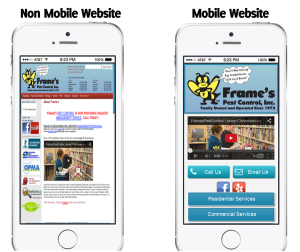What changes they’ve made and how you can be ready.
For quite some time, Google has recommended that website owners ensure their websites are mobile-friendly. Now, they’ve upped the ante with an announcement that a lack of mobile friendliness will impact search engine ranking. Starting on April 21st 2015, Google rolled out a new algorithm which gives preference to mobile-friendly websites. Google explains what this all means in detail here.
Essentially, if your website isn’t mobile-friendly, no matter how relevant and up-to-date your content is, it won’t show up in prime position in a Google search. This means if you’re a small business, it’s even more important to optimize your website and help your company stand out against your larger competitors. A mobile-friendly website will help ensure that Google is bringing traffic, and therefore potential customers, to your website.
Why the change?
Recent statistics show that almost 60% of people using Google are doing so on mobile devices. It’s predicted that, soon enough, mobile internet use will overtake desktop use. By making mobile-friendly websites a necessity for website owners, Google is ensuring that all users have a smooth and easy experiences whatever device they are using.
What Does “Mobile-Friendly” Mean?
Basically, a mobile-friendly website is a website that can easily be viewed and navigated on a mobile device. This means:
-
Buttons and links that can be pressed easily.
-
Text that can be read on a small screen without needing to zoom in and out.
-
Simple navigation – e.g. menus that can be selected readily.
-
Content that can actually be viewed – i.e. content that fits on the screen, and can be viewed on all devices. Flash content won’t work on iOS, for example.
Google will now be looking for all these things when determining search engine rankings.
Other things that are considered unfriendly include:
-
Popups – popups prevent viewers from accessing content and get in the way of an easy viewing experience.
-
Poorly sized embed codes – be careful of third party embedded widgets, including signup forms, videos and checkouts. Not all codes are mobile-friendly and should be correctly sized accordingly.
What Should I Do?
First of all, don’t panic. It’s not too late to have your website optimized for mobile viewing. And, chances are, your website is already mobile-friendly. Many CMS platforms, such as WordPress, are already mobile-friendly or will have mobile-friendly updates available. To find out whether or not your website is mobile-friendly, you can run a quick and easy test on Google’s mobile-friendly webmaster tool here.
If your website isn’t mobile-friendly, there are a few steps to take and important things you need to consider.
-
The viewport tag. The viewport tag is an html tag that defines your viewport, or the area of the screen that is visible to the device. It’s important that you set your viewport tag as Google sees that as purposely making your site visible on mobile devices.
-
Site configuration. Probably the most important thing to consider is how you are going to set your website up to be mobile-friendly. There are three different routes you can take:
-
Responsive website. Responsive websites can automatically detect whether it’s being viewed on a mobile device, as opposed to a desktop computer or laptop, and will adjust its interface accordingly.
-
Dynamic serving. A dynamic serving website is similar to responsive websites, but goes a step further by delivering different content to different devices. For example, someone viewing the website on a desktop device might see more images and less text than someone viewing on a mobile. This kind of website is usually operated by larger companies, such as Amazon.
-
A separate mobile site. Sites that begin with m. are mobile specific websites. If you’re on a mobile device you’ll be automatically redirected to a mobile website by Google.
Google doesn’t have a preference regarding these three different mobile-friendly methods, so there are no ranking benefits depending on which you choose. However, a dedicated mobile website helps maintain brand consistency, so your visitors know exactly where they are when visiting your website via a desktop or mobile device.
-
Avoiding faulty redirects. When visitors search for content on Google, they are usually looking for something very specific. If a visitor clicks on a subpage that doesn’t provide the information they are looking for, Google considers it a redirect. A mobile-optimized website helps to prevent redirects, keeps Google happy and won’t frustrate your visitors.
-
Canonical tags. Canonical tags are vital for dedicated mobile websites. They are the HTML tags that tell Google that the page is mobile-friendly and allow you to avoid Google’s duplicate content penalty.
-
Optimized speed. Ensuring that your website doesn’t take a long time to load on a mobile device is also very important. Test your speed using Google’s tool here.
If all of this is leaving you feeling overwhelmed and concerned for the future of your small business, be rest assured that there are people who can help. Mobile website specialists, such as Sonya Ramsey, can help you recreate your website and ensure that it is performing in the best way possible. Sonya will work closely with you to create a plan that suits your business needs and budget. You’ll have a mobile-friendly website in no time at all.
Contact Sonya Ramsey for a free 30 minute consultation to determine your next steps.
www.modigitale.com/contact
sonya@modigitale.com
https://www.facebook.com/mobilesonya
http://www.twitter.com/mobilesonya







